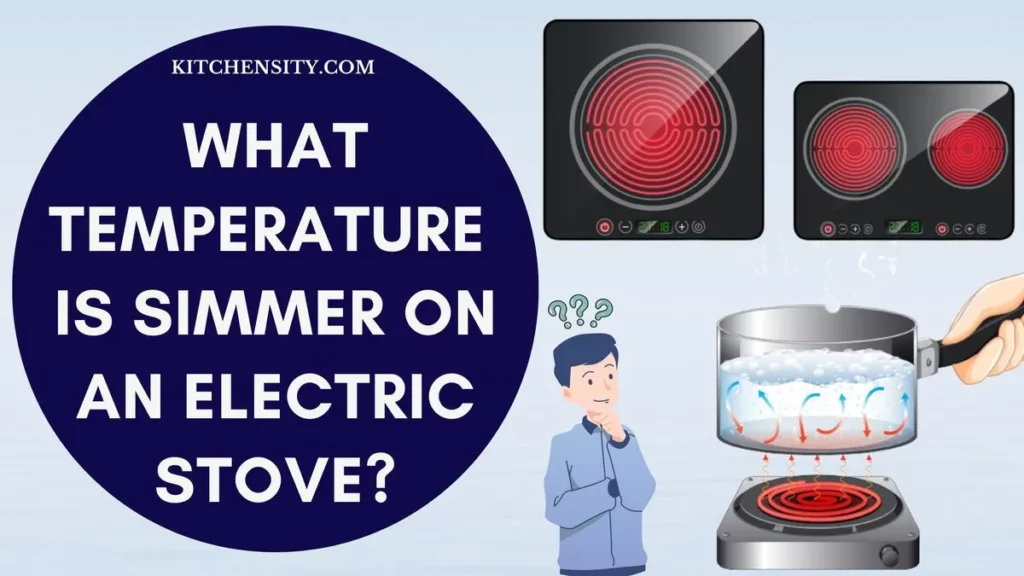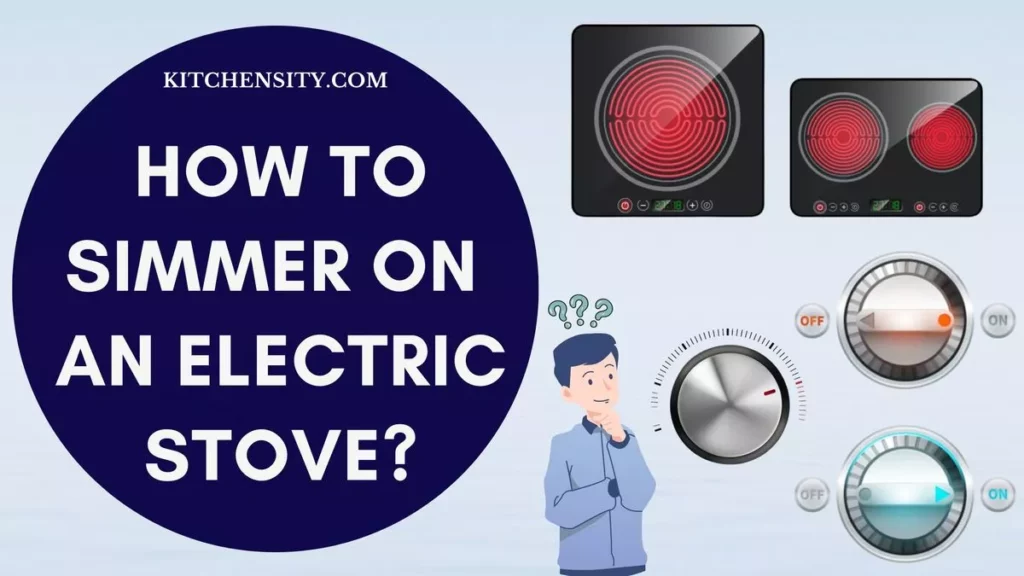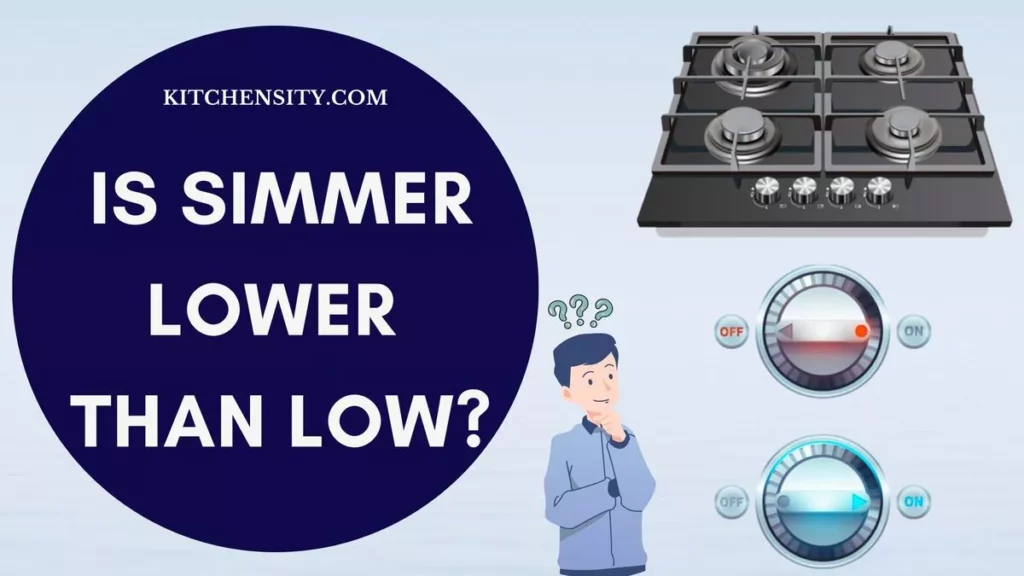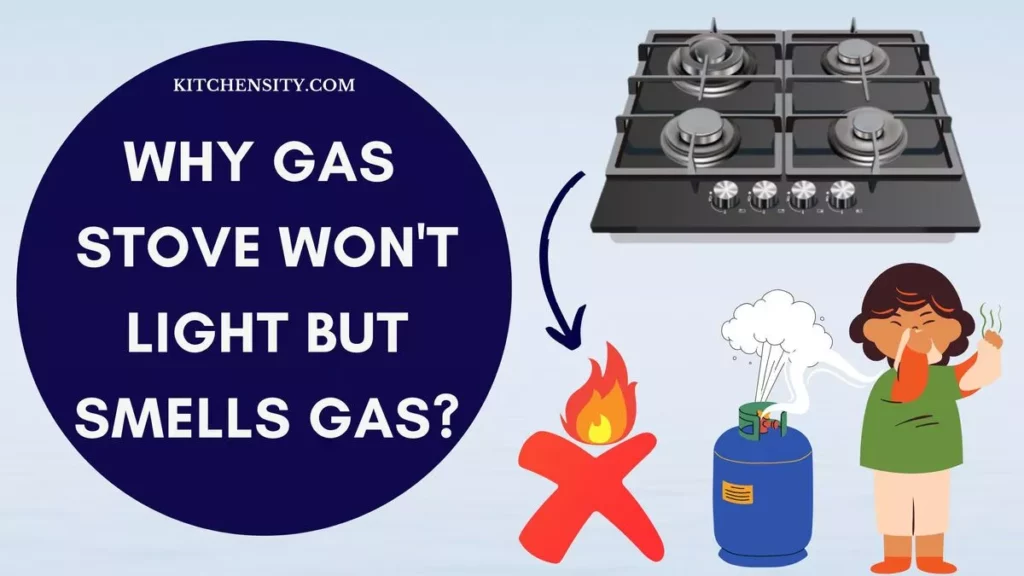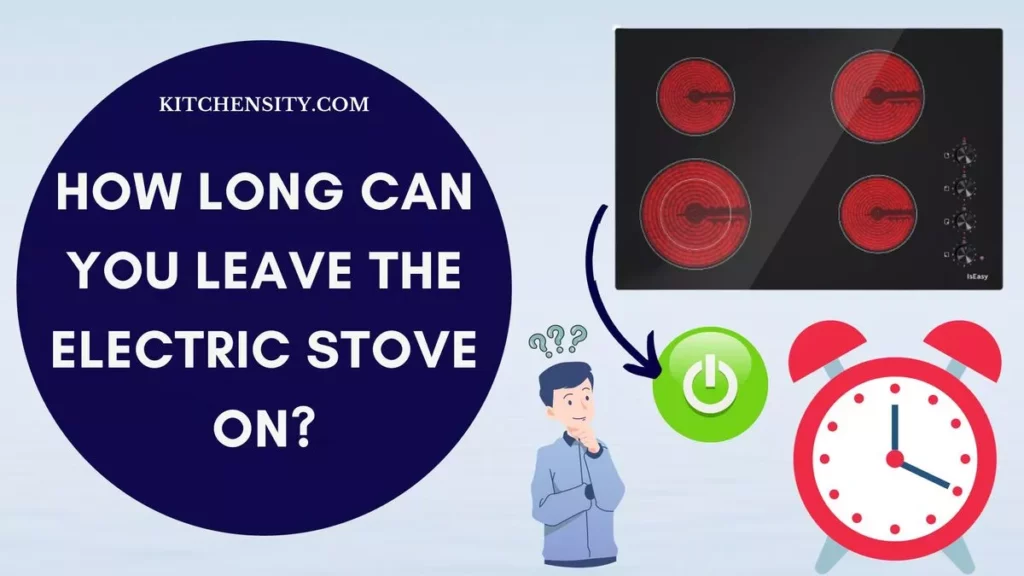In the world of cooking appliances, gas stoves are a popular choice for their efficiency and precise temperature control.
However, not all gas stoves are created equal. Some are designed to run on natural gas, while others are configured for propane.
But what if you find yourself in a situation where you need to use propane on a natural gas stove or vice versa? Is it safe?
What happens if you attempt such a switch?
In this article, we will explore the implications of using propane on a natural gas stove and the potential risks involved.
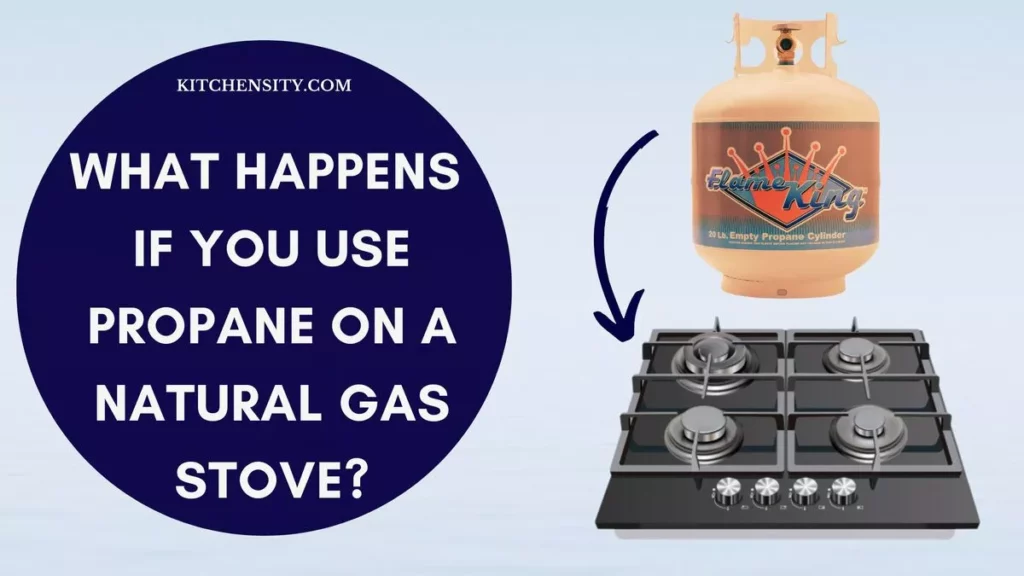
Table of Contents
- 1 What Happens If You Use Propane On A Natural Gas Stove?
- 2 Understanding The Basics
- 3 Risks Involved When You Use Propane On A Natural Gas Stove
- 4 Can A Natural Gas Stove Be Used With Propane?
- 5 How Do You Know If Your Gas Stove Is Natural Gas Or Propane?
- 6 How Do You Convert A Natural Gas Cook Stove To Propane?
- 7 Natural Gas To Propane Conversion Calculator
- 8 Final Verdict On Using Propane On A Natural Gas Stove
- 9 Frequently Asked Questions (FAQs)
What Happens If You Use Propane On A Natural Gas Stove?
Using propane on a natural gas stove can lead to safety hazards and inefficient operation. Propane, being heavier than air, can accumulate and potentially cause explosions in the presence of a spark.
Additionally, the pressure and combustion characteristics of propane differ from natural gas, leading to incomplete combustion, harmful emissions, and possible damage to the stove.
Please continue reading below for in-depth explanations.
Also Read – Master Medium Heat On A Stove
Understanding The Basics
Understanding the differences in gas composition and the corresponding regulators is essential when considering the safe and efficient use of natural gas and propane appliances.
Mixing up these gases or using the wrong regulator can lead to serious safety hazards, which we will explore further in the subsequent sections.
1. Different Types Of Gas (Natural Gas Vs Propane)
To comprehend what happens when you use propane on a natural gas stove, you must first understand the fundamental differences between these two gases.
Natural Gas
- Natural gas is a fossil fuel primarily composed of methane, a hydrocarbon gas that occurs naturally underground.
- It’s extracted from reservoirs deep within the Earth’s crust. One of the key characteristics of natural gas is that it is odorless, colorless, and lighter than air.
- This lack of odor can be a safety concern because, in its natural state, it is challenging to detect any leaks.
- Natural gas is widely used in households and industries for various purposes, including heating, cooking, and electricity generation.
- Due to its abundance and relatively low cost, it has become a popular choice for powering gas stoves and other appliances.
Propane Gas
- Propane, on the other hand, is a hydrocarbon gas that is a byproduct of both natural gas processing and crude oil refining.
- It’s heavier than air and possesses a distinct, pungent odor.
- Manufacturers intentionally add this odor to propane for safety reasons, making it easier to detect gas leaks, as even small leaks can pose significant risks.
- Propane is stored in a pressurized liquid form and vaporizes into a gas when released from its container. This characteristic makes it well-suited for use in portable tanks and cylinders.
- Propane is commonly used for heating homes, cooking, fueling vehicles, and operating various appliances, including grills and camping stoves.
Also Read – Should A Slow Cooker Simmer On Low?
2. The Role Of Regulators
Both natural gas and propane appliances are equipped with regulators that play a crucial role in controlling the flow of gas from the source to the burner. These regulators are specially designed to match the specific properties of the gas they are intended for.
Natural Gas Regulators
- Natural gas regulators are calibrated to handle the lower pressure at which natural gas is distributed.
- They ensure a steady and safe flow of natural gas to appliances such as stoves and water heaters.
- The regulator’s job is to reduce the pressure from the supply line to a level suitable for safe and efficient combustion.
Propane Gas Regulators
- In contrast, propane gas regulators are designed to accommodate the higher pressure at which propane is stored in its liquid form.
- These regulators play a similar role in reducing pressure but are tailored to the characteristics of propane.
- They ensure that the gas flows at the right rate and pressure for appliances like propane grills, heating systems, and camping stoves.
Also Read – Is Simmer Lower Than Low?
Risks Involved When You Use Propane On A Natural Gas Stove
Using propane on a natural gas stove can have potentially dangerous consequences due to the fundamental differences between these two types of gases. Here’s a detailed explanation of what happens when you attempt to use propane on a natural gas stove:
1. Incompatible Pressure Levels
Natural gas and propane are stored and distributed at significantly different pressure levels. Natural gas is delivered to homes and appliances at relatively low pressure, typically around 6-7 inches of water column (WC).
Propane, on the other hand, is stored as a high-pressure liquid and is delivered at a much higher pressure, usually around 10-11 inches of WC. When you attempt to use propane on a natural gas stove, the pressure mismatch can lead to problems.
2. Inefficient Combustion
The pressure difference directly affects the flow rate of gas into the stove’s burners. When propane, which has a higher pressure, is fed into a natural gas stove, the burners receive more gas than they are designed to handle. This results in an inefficient combustion process.
The excess propane can lead to incomplete burning of the gas, causing a yellow, sooty flame. Incomplete combustion produces harmful byproducts, including carbon monoxide (CO), which is both toxic and a potential health hazard.
3. Risk of Explosion
Perhaps the biggest danger of using propane on a natural gas stove is the risk of explosion. Propane, being heavier than air, can accumulate in enclosed spaces like a kitchen if there is a leak.
The accumulation of propane in the vicinity of a natural gas stove can lead to a dangerous situation. Even a minor spark, such as igniting the stove burner, can trigger a powerful explosion due to the higher concentration of propane in the air.
4. Potential Appliance Damage
Using the wrong type of gas can also damage the stove’s internal components. The higher pressure associated with propane can put stress on the stove’s gas valves, burners, and other parts, potentially causing them to malfunction or wear out prematurely. This can result in costly repairs or the need to replace the stove altogether.
5. Safety Concerns
Beyond the immediate dangers, using propane on a natural gas stove can create ongoing safety concerns. Since propane leaks are more challenging to detect due to their lack of odor, the potential for gas buildup and leaks in the kitchen increases, posing a continuous safety risk to occupants.
So, attempting to use propane on a natural gas stove is not only inefficient but also highly dangerous. It can lead to inefficient combustion, harmful byproducts, the risk of explosion, appliance damage, and ongoing safety concerns.
To ensure safety and proper stove functionality, it’s essential always to use the correct type of gas with the appropriate stove and consult the manufacturer for a proper conversion kit if necessary. Safety should always be a top priority when dealing with gas appliances in your home.
Also Read – How To Simmer On An Electric Stove?
Can A Natural Gas Stove Be Used With Propane?
Yes, a natural gas stove can be used with propane, but it requires a few essential modifications to ensure safe and efficient operation. Here’s what you need to know if you want to use propane with a natural gas stove:
- Conversion: The most crucial step in using propane with a natural gas stove is acquiring a conversion kit designed for your specific stove model. These conversion kits are provided by the stove manufacturer or authorized dealers. The kit typically includes replacement orifices for the burners and sometimes adjustments to the stove’s regulator.
- Professional Installation: Converting a natural gas stove to run on propane is not a DIY project. It’s essential to hire a qualified technician or a licensed gas fitter to perform the conversion. They have the knowledge and experience to ensure that the modifications are done correctly, guaranteeing safety and efficiency.
- Orifice Replacement: The orifices are small openings at the base of each burner that control the flow of gas. In a conversion, the natural gas orifices must be replaced with ones designed for propane. Propane orifices are smaller to accommodate the higher pressure of propane gas.
- Regulator Adjustment: In some cases, the stove’s regulator may need to be adjusted to accommodate the higher pressure of propane. This adjustment ensures that the correct amount of propane flows to the burners.
- Testing and Inspection: After the conversion is complete, the technician will thoroughly test the stove to ensure it functions correctly and safely. They will check for gas leaks and ensure that the burners produce a clean and efficient flame.
- Propane Tank and Hose: If you’re converting a natural gas stove for outdoor use, such as a barbecue grill, you’ll also need a propane tank and hose. These components connect the stove to the propane supply.
It’s essential to emphasize that using propane on a natural gas stove without the proper conversion is unsafe and can lead to serious hazards, including explosions and incomplete combustion.
Therefore, always consult the manufacturer’s guidelines and recommendations when considering a conversion.
Also Read – What Temperature Is Simmer On An Electric Stove?
How Do You Know If Your Gas Stove Is Natural Gas Or Propane?
Determining whether your gas stove is configured for natural gas or propane is crucial for safe and efficient operation. Here’s how you can find out which type of gas your stove is designed for:
- Check The Stove’s User Manual:
- The easiest and most reliable way to determine the type of gas your stove is designed for is by referring to the user manual or documentation that came with the appliance.
- The manual will typically specify whether the stove is configured for natural gas or propane.
- If you no longer have the manual, you can often find it online by searching for your stove’s model number on the manufacturer’s website.
- Look For Labels Or Stickers:
- Manufacturers often affix labels or stickers to the stove that indicate the type of gas it is designed to use. These labels are usually located on the back, sides, or bottom of the stove.
- Look for phrases like “Natural Gas Only” or “Propane Use Only.” If you find such a label, it provides clear confirmation of the gas type.
- Contact The Manufacturer:
- If you’re unable to locate the user manual or any labels on the stove, you can contact the manufacturer’s customer support or visit their website.
- Provide them with your stove’s model and serial number, and they can help you determine the gas type it was originally configured for.
- Examine The Gas Supply Line:
- If you’re still uncertain, you can inspect the gas supply line that connects to your stove.
- Natural gas lines typically have a larger diameter than propane lines. If the gas supply line is labeled or color-coded, it can also provide a clue about the type of gas being used.
- However, this method is less reliable, as supply lines can be replaced or modified over time.
- Check The Burner Orifices:
- This method should only be used if you have experience with gas appliances or are working with a qualified technician.
- By removing a burner and examining the orifice (the small opening where gas flows into the burner), you can sometimes determine the gas type based on the size of the orifice.
- Natural gas orifices are larger than propane orifices due to the differences in gas pressure.
- However, this method is not foolproof, and it’s always safer to consult the manufacturer or a professional.
Identifying whether your gas stove is configured for natural gas or propane is essential for safety and proper operation. The user manual, labels on the stove, manufacturer guidance, and, as a last resort, inspection of the gas supply line or orifices can help you determine the gas type.
When in doubt, it’s advisable to seek assistance from a professional technician or the stove’s manufacturer to ensure accurate information and safe usage.
Also Read – What Does Simmer Look Like?
How Do You Convert A Natural Gas Cook Stove To Propane?
Converting a natural gas cook stove to propane requires careful adjustments and specific components to ensure safe and efficient operation. Here are the steps involved in converting a natural gas cook stove to propane:
- Acquire A Conversion Kit:
- The first step is to obtain a conversion kit designed for your specific cook stove model.
- These kits are typically provided by the stove manufacturer or authorized dealers.
- The kit will include all the necessary components and instructions for the conversion.
- Turn Off The Gas Supply: Before beginning any work on your stove, ensure that the gas supply to the appliance is turned off. Locate the gas shut-off valve either behind the stove or at the main gas supply line and close it.
- Remove The Burners: Carefully remove the burners and their associated components from the cooktop. Depending on your stove’s design, you may need to lift the cooktop to access the burner orifices.
- Replace The Orifices:
- The orifices are small openings at the base of each burner that control the flow of gas.
- In the conversion process, you will need to replace the natural gas orifices with ones designed for propane.
- Propane orifices have smaller openings to accommodate the higher pressure of propane gas.
- Adjust The Regulator: Some stoves may require an adjustment to the regulator, which controls the gas pressure. This step should be outlined in the conversion kit’s instructions. If necessary, follow the provided guidelines to modify the regulator to match the requirements of propane.
- Reassemble The Burners: Once the orifices and regulator have been adjusted or replaced, reassemble the burners and their associated parts, ensuring they are securely in place.
- Check For Leaks:
- Before turning on the gas supply, it’s crucial to check for gas leaks.
- Apply a solution of soapy water to all the connections, including the orifices and any connections you may have loosened during the conversion.
- If you see bubbles forming, it indicates a gas leak. In such a case, immediately turn off the gas supply and tighten the connections until the leak stops.
- Test The Stove:
- Once you are confident that there are no leaks, you can turn on the gas supply.
- Test each burner to ensure they ignite and produce a clean, blue flame.
- Make sure the flame doesn’t flicker or produce excessive yellowing, which can indicate an issue with combustion.
- Monitor For Proper Operation: Keep an eye on the stove during the initial use to ensure it operates correctly. If you notice any irregularities, such as uneven flames or inconsistent heating, consult the conversion kit’s instructions or a professional technician.
- Verify With A Professional: For added safety and peace of mind, consider having a qualified technician or a licensed gas fitter inspect your converted stove to ensure it meets safety standards and is functioning optimally.
It’s essential to follow the specific instructions provided in the conversion kit and to consult your stove’s user manual to ensure a successful and safe conversion.
Converting a natural gas cook stove to propane should only be done by individuals with the necessary skills or by hiring a professional to perform the conversion. Safety should always be the top priority when working with gas appliances.
The Importance Of Conversion Kits
When it comes to converting a gas appliance from one type of gas to another, such as converting a natural gas cook stove to run on propane, the use of conversion kits cannot be overstated.
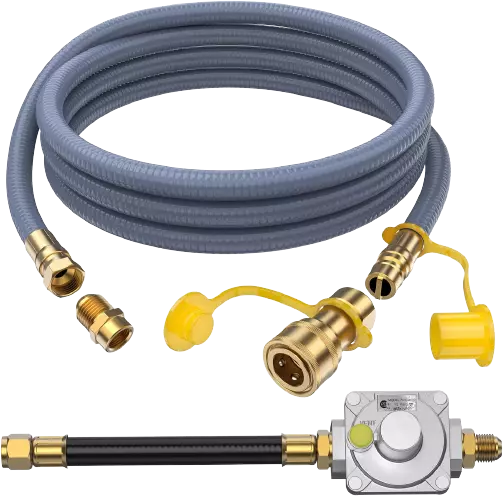
These kits play a critical role in ensuring the safety, efficiency, and proper functionality of the appliance after the conversion. Here’s why conversion kits are of utmost importance:
- Safety:
- Safety is the paramount concern when dealing with gas appliances.
- Using the wrong type of gas or improperly converting an appliance can lead to gas leaks, explosions, fires, and health hazards.
- Conversion kits are designed to facilitate a safe transition from one gas type to another.
- They provide the necessary components and instructions to make the conversion as safe as possible.
- Proper Component Matching:
- Gas appliances are finely tuned machines with specific components designed to work with a particular gas type.
- Conversion kits ensure that the replacement parts, such as orifices and regulators, are precisely matched to the new gas type. This compatibility is crucial for the appliance’s correct operation.
- Efficiency:
- Proper conversion kits are engineered to maintain the efficiency of the appliance.
- They ensure that the gas flows at the right rate and pressure for optimal combustion.
- This efficiency not only saves energy but also ensures that the appliance operates as intended, providing consistent heating or cooking performance.
- Compliance With Regulations:
- Gas appliances are subject to various safety and regulatory standards.
- Using a conversion kit recommended by the appliance manufacturer helps ensure compliance with these regulations.
- It reduces the risk of unauthorized modifications that might void warranties or violate safety codes.
- Minimizing Environmental Impact:
- Efficient combustion is not only about performance but also about minimizing the environmental impact.
- Properly converted appliances produce fewer emissions, reducing their carbon footprint.
- Conversion kits help achieve this environmental goal by ensuring that the appliance burns gas cleanly and efficiently.
- Peace Of Mind:
- Knowing that your gas appliance has been converted using an authorized conversion kit provides peace of mind.
- It eliminates doubts about the safety and functionality of the appliance, allowing you to use it with confidence.
- Manufacturer’s Recommendations:
- Most gas appliance manufacturers provide conversion kits for their products.
- Using these kits is not only recommended but is often required to maintain the warranty and ensure that the appliance performs as expected.
- Deviating from manufacturer recommendations can lead to warranty voidance and potential liability in case of accidents.
How Much Does It Cost To Convert A Gas Stove To Propane?
The cost to convert a gas stove to propane depends on the make and model of the stove, the labor costs in your area, and the cost of the propane conversion kit. In general, you can expect to pay anywhere from $100 to $300 for the conversion.
Here is a breakdown of the costs involved:
- Propane Conversion Kit: This is the most expensive part of the conversion, and the cost will vary depending on the make and model of your stove. Kits typically range in price from $50 to $200.
- Labor: The labor costs will vary depending on the complexity of the conversion and the hourly rate of the technician. In general, you can expect to pay between $50 and $100 per hour for labor.
- Gas Line Inspection: If your stove is currently connected to a natural gas line, you will need to have a qualified technician inspect the line to make sure it is safe to use with propane. This inspection typically costs around $50.
Here are some additional factors that can affect the cost of converting a gas stove to propane:
- The Age Of Your Stove: Older stoves may require more extensive modifications than newer models.
- The Location Of Your Stove: If your stove is located in a difficult-to-access area, the labor costs will be higher.
- The Availability Of Propane In Your Area: If propane is not readily available, the cost of the conversion kit may be higher.
If you are considering converting your gas stove to propane, it is important to get quotes from several different technicians to get the best price. You should also make sure that the technician you choose is qualified to perform the conversion.
Here are some tips for getting the most out of your propane conversion:
- Choose A Reputable Technician: Make sure the technician you choose is licensed and insured.
- Get Multiple Quotes: Get quotes from several different technicians to get the best price.
- Ask About The Warranty: Make sure the technician offers a warranty on their work.
- Be Prepared To Pay For The Propane Conversion Kit: The cost of the kit will vary depending on the make and model of your stove.
- Be Patient: The conversion process can take several hours, so be patient and let the technician do their job.
Also Read – Can Induction Pans Be Used On Gas Stoves?
Natural Gas To Propane Conversion Calculator
Calculating the cost of converting from natural gas to propane can be a bit complex, as it depends on several variables, including the type of appliance, the availability of conversion kits, and labor costs. However, you can estimate the cost using a simplified formula:
Total Conversion Cost = Cost of Conversion Kit + Labor Costs + Materials + Gas Permit + Safety Inspection (Optional)
Let’s break down each component:
- Cost of Conversion Kit: This cost varies depending on the brand and model of your appliance. You can usually find this information on the manufacturer’s website or by contacting them directly.
- Labor Costs: If you plan to hire a professional technician for the conversion, this cost will depend on their hourly rate and the complexity of the job. You can inquire about labor rates from local service providers.
- Materials: This includes any additional materials and supplies you need, such as pipe thread sealant, pipe fittings, and tools. Estimate these costs based on your specific requirements.
- Gas Permit: Check with your local authorities or gas utility company to determine if you need a permit for the conversion. The permit fee varies by location.
- Safety Inspection (Optional): If you choose to have a safety inspection performed after the conversion, factor in the associated cost.
Here’s a simplified formula to calculate the total conversion cost:
Total Conversion Cost = Cost of Conversion Kit + (Labor Rate × Hours of Labor) + Cost of Materials + Gas Permit Fee + Cost of Safety Inspection (if applicable)
Keep in mind that this calculation provides only an estimate, and actual costs may vary. To get a precise figure, it’s advisable to obtain quotes from technicians or service providers in your area and consult with your appliance manufacturer for specific conversion kit pricing.
Additionally, remember that safety is paramount when dealing with gas appliances, so it’s crucial to follow local regulations and, if necessary, consult a professional technician to ensure a safe and successful conversion.
Final Verdict On Using Propane On A Natural Gas Stove
The decision to use propane on a natural gas stove or vice versa is not one to be taken lightly. As we’ve explored in this article, the consequences of such a choice can range from inefficient combustion and appliance damage to the gravest danger of explosions and health hazards.
To ensure the safety of your home and loved ones, it is imperative to always use the correct type of gas with the appropriate stove.
While conversion kits can facilitate a change from one gas type to another, they must be used in strict adherence to manufacturer guidelines and, if necessary, by qualified professionals. Safety inspections and adherence to local regulations are non-negotiable steps in this process.
In the world of gas appliances, precision and safety go hand in hand. Understanding the distinctive properties of natural gas and propane, and the role of conversion kits, is essential for responsible and informed decision-making.
By prioritizing safety, you can continue to enjoy the benefits of your gas stove without compromise, ensuring that the heart of your kitchen remains both a source of culinary delight and a sanctuary of well-being.
Frequently Asked Questions (FAQs)
-
Can I Use Propane On A Natural Gas Stove In An Emergency?
In emergencies, it’s best to use alternative cooking methods like camping stoves or grills specifically designed for propane. Using propane on a natural gas stove can be dangerous and is not recommended.
-
Is It Possible To Convert A Natural Gas Stove To Propane Or Vice Versa?
Yes, it is possible to convert a stove from one gas type to another using a conversion kit provided by the manufacturer. However, it should be done by a professional to ensure safety and proper operation.
-
What Are The Signs Of A Gas Leak?
Signs of a gas leak include a strong odor (for propane), hissing sounds, and a noticeable decrease in appliance performance. If you suspect a gas leak, immediately turn off the gas supply, evacuate the area, and contact your gas provider or emergency services.
-
How Can I Maintain The Safety Of My Gas Stove?
Regular maintenance, including cleaning and inspection, can help ensure the safety of your gas stove. Additionally, be attentive to any unusual odors or sounds, and always follow the manufacturer’s guidelines for use.
-
Can I Use Natural Gas Appliances With Propane And Vice Versa?
In most cases, appliances are designed to work with a specific type of gas. Using the wrong gas can be dangerous and may void warranties. Always consult the manufacturer and use the correct gas type for your appliances.
Katrina Smith is a seasoned expert with over 25 years of experience in all things related to cooking and the kitchen. As an avid cook and kitchen enthusiast, she is passionate about sharing her knowledge and expertise on cookware, kitchen appliances, kitchen tips, and kitchen staples.
Through her articles and reviews, Katrina aims to inspire and help others improve their cooking skills, experiment with different ingredients, and invest in quality cookware and appliances.

